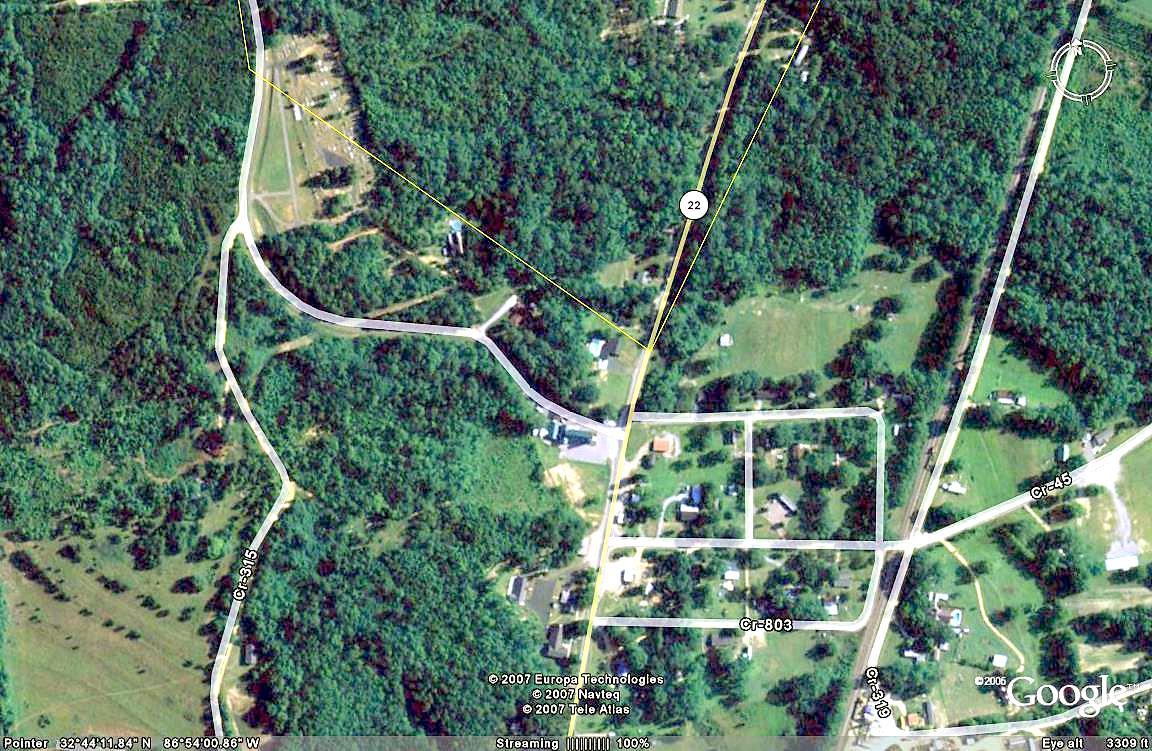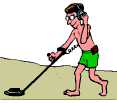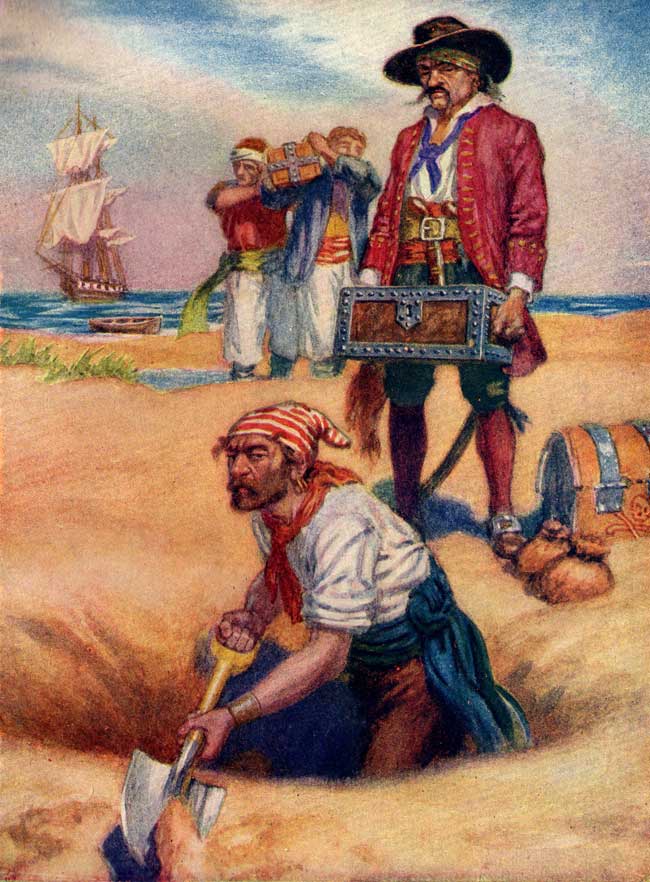|

A great way to help find treasure hunting sites is to use topographical maps and aerial photographs! Above is an aerial
photo of Ebenezer Church battlefield available from Google Earth. It even gives GPS coordinates!
Tip for relic, coin and cache hunters:
Make a list of your family members and neighbors that are say 60 yrs. old and up. Then add people you know
with relatives that fall into this age bracket. The reason for this is simple.....
When they were kids, teen agers, and young adults...cities, towns, and surrounding areas were much different from what
they are today. Houses, school yards, churches, encampments, cemeteries, parks, sports areas, swimming holes, as well as old
roads, paths, drive ways, logging camp locations, battle sites, etc. In many cases were 50 to 100 years then. Think about
it! these places are now 100 to 150 years old, possibly even much older.
There are many other ways to contact people in this age group. Family Reunions, Senior Citizens Groups, Stores and Gas
Stations on the edge or outside city and town limits, etc. Maybe you know someone in a rest home. These people will talk with
you for hours and be grateful for the company. Use your imagination and soon your information sources will become endless.
More often than not these places will exist in someone's memory, not as a written record. Always have a map handy when
talking with someone about locations from "days gone by." That way you can mark the general locations and then cross check
this data with other people in that same area. If you don't have a map, then paper and pencil to draw one will do.
When I go into a new area to relic hunt, I try to find the oldest person in the area to talk to. "They usually love to
talk about old times". I have been directed to some very productive relic sites this way and met some very nice people.
Take advantage of natures fury! check local news papers and historical societies. Unfortunately, violent storms such as
tornadoes have totaly destroyed entire towns for many years and removed nearly all traces of them. With a little research
and work, you can uncover a treasure trove of relics. Just remember not to trespass and always obtain permission!
Farming areas..... It never hurts to stop at a farm house and ask directions ( even though you aren't lost ). You may even
find yourself holding a cup of coffee, glass of ice water or tea and maybe a sandwich for your trouble. While you are there
mention what your interest are, the response may surprise you. I have had offers to ride down the road and show me a spot
just like what I was hopping to find when I started out that day. In some cases they even ask if I would like to hunt around
their place. Maybe even look for a lost item.
Look close while you are there! I have seen old farm tools,cannon balls, insulators, and other items being used as door
stops, or maybe just laying around the porch, at the end of a flower bed or hedge row, on the dirt floor or around the outside
of an old abandoned shed, or barn. Sometimes, for a few dollars I would have a prize. Oh yes; don't forget to look up, not
just down !
That old saying....."One Person's Trash Is Another Person's Treasure" is more true today than ever before, and people
will pay well for it too !
In closing just remember.....There are more valuable items yet to be found, than the total of everything found to date.
The more creative you become the better your chances of finding your fair share.
Coil Usage!
Here's a trick that will make your detector's standard loop size more versatile when hunting trashy "hunted out" park areas
while using a 8" to 9.5" size loop. When you hit a trashy area, raise your loop a couple of inches off the ground and scan
the area again. This will narrow the pattern that your search coil sends into the ground, only allowing it to "see" a much
smaller area (depending on how far you hold the coil away). This enables your deep seeking loop to act much like the smaller
coil, giving you greater separation in areas of high trash (that can "mask" valuable targets), yet allows you to find the
deep signals when conditions permit. Your detector's loop sends a signal into the ground much like the shape of a funnel.
This is also why overlapping the passes you make with your loop is critical when detecting those very deep signals. ~Good
luck to you in bringing home the keepers that the others missed.
Research Pays!
When I first began hunting for civil war relics, I made a trip to the largest city library and went to the history archives.
I found actual diaries written by soldiers that took part in the battle I was interested in. WOW! what a lot of insight this
provided. I also located a hand drawn map of the battlefield and was allowed to make a photo copy of it.
My next trip to this battlefield site, I found myself standing in the remains of the actual entrenchments and visualizing
cannon fire. I found many battle relics that day and still go back every chance that I get.
Here in Alabama, the battlefield sites are limited and fastly becoming inaccessable because of laws and new homes being
built! The time to look is now!
TIP: When hunting for old relics, ( ALWAYS} use all metal mode on your detector! This way, you will get the greatest depth
possible and not miss any iron objects such as cannon balls, bullets, guns, knives etc. Most civil war sites have been hunted
over and over again.......BUT, THEY NEVER FIND IT ALL!

BEACH HUNTING!
Detecting on the beach can be one of the most pleasurable forms of detecting. Shuffling down the beach in the sun, swinging
your detector is a great way to spend the day. The ease of target retrieval in the soft sand is an added bonus. Many people
agree and there is a growing community of beach hunters. To become a successful beach hunter you can use a variety of strategies.
Some of these strategies can be implemented immediately and some of them take time and observation. The most successful hunters
will use all these strategies and generate their own insights as their experience grows.
The number of targets at any
detecting site, including the beach, can be derived from a simple equation composed of four variables. These variables are
the length of TIME the site has been in use, the NUMBER of people that visit the site, the level of physical ACTIVITY people
engage in at the site and the environment, or GROUND COVER, that can hide objects that have been dropped. Another variable
to consider is the TYPE of people frequenting the site.
Time and site population are a consideration, but they can
be deceiving. There have been many great finds at sites that are not very old. There can also be sites that appear to be unused
today but were heavily used in the past. A little research can pay big dividends in this regard. For modern beaches presently
in use the seasons also play a part. More people visit the beach in the summer.
Activity refers to the type of play
people engage in at the site. Playing volleyball, frolicking in the waves, playing catch and throwing a Frisbee would all
be considered activities that result in more valuables being lost.
The beach has three kinds of ground cover. There
is dry sand, wet sand and water. Water is the best ground cover. Water prevents a visual search and the movement of the water
can displace dropped objects. The sand is almost as good since objects are quickly swallowed up.
In general, all types
of people use the beach. They do, however, congregate by age group for certain activities. The younger folks are usually more
apt to wear valuables and be more active. Some of the older folks will be more cautious and leave their valuables in the car
or hotel.
When you are at the beach, take a look around. You may see kids on the play sets with mom nearby, teenagers
playing volleyball, a swath of sunbathers on towels and blankets, families playing in the wet sand and people playing in the
water. Consider the variables presented above and apply them to what you see. It is evident that all these beach areas have
potential.
It is important to understand that the beach is always changing. Waves, currents, storms, wind and rain
can dramatically change beach geography. Buried objects behave predictably in this environment. Most metal objects are denser
than the surrounding sand and will bury themselves deeper and deeper over time. The beach actually vibrates due to the pounding
surf which accelerates this process. Objects will continue to sink until they come to rest upon a denser surface. This could
be a layer of gravel or clay. The point here is that you want to look for areas of the beach that have had a lot of sand removed.
If you see gravel or clay, or deep cuts in the sand, then you would want to hunt those areas. Objects also migrate along the
beach. A current washing along a beach will deposit objects of similar density in the same place. This will result in a line
of objects varying from lightest to heaviest along the beach. If you pay attention to the trash items deposited by the current
and look for the heavier objects there is a good chance valuable items will be in the same place.
The beach is subject
to other phenomenon, namely tides and wind. During low tide, areas that were deep water are now shallow and shallow water
is now wet sand. This allows you to get farther out and hunt areas that are difficult to hunt at any other time. There are
a few times a year that the tides are very low. They are called minus tides. If you can time your trip for one of these tides
you will find that you can venture out much farther than at any other time of the year. Wind can lower the water level if
it is blowing out to sea. If you can hit the beach during a minus tide with the wind blowing out to sea, do not miss the chance
to do so.
Once you have analyzed the beach variables and geography it is time to choose the type of hunting you would
like to do, or the type you think would be the most productive. These include hunting the deep water, shallow water, wet sand
or dry sand.
Hunting the deep water requires a submersible detector and can be physically challenging. Wave action
can make deep water hunting very difficult. If your beach is not too rough, hunting the deep water can be very rewarding.
Cool water tends to shrink fingers and people can lose rings without even knowing it. Diving under the water can cause necklaces
to slip over the head, or they can break off in the surf.
Shallow water requires, at least, a submersible coil. It
is much easier than hunting deep water and many finds can be had. A lot of people will get into the shallows and sit in the
water or splash around. Since this is the place where people are initially affected by the cold water many items are lost
here.
The wet sand is a great area to hunt. Families play in this area and people going into or coming out of the water
can lose items. A mother building a castle in the wet sand with her child can lose a ring or break a bracelet while digging
in the sand. It is also where people walk or run along the beach. There is a lot of activity in this area and people tend
to congregate where the wet sand meets the shallow water.
The dry sand has many potentially good areas. One of them
is the line along the beach where people lay their towels and blankets. When people leave and shake out their towel they may
scatter items they accidentally left on their towel. They may get up to run to the water and the slippery suntan lotion will
cause rings to slip off their fingers. It is also a place where people spend a lot of time, increasing the likelihood of losing
items. The rest of the dry sand area can be compared to an inland park. The volleyball courts and play sets can generate finds.
The paths that people walk to and from their cars are another good area. Any route where people are forced through a narrow
path is a place you would want to hunt.
One other item to consider, at least on some beaches, is competition. If a
lot of detectorists hunt the beach in your area then you may have to time your hunts to get the fresh drops. The most obvious
way to do this is to get to the beach as the crowds are leaving and hunt into the evening. Luckily, most beaches are very
large and there is plenty of ground for everyone. A lot of fellow detectorists on the beach can be a good thing. Get to know
them, share stories of your finds and you will discover that you may have a new detecting partner, or a new site to hunt that
they have shared with you.
Do not forget to dispose of all the trash you find!

COIN HUNTING TIPS!
|

